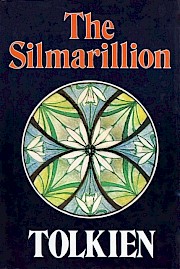☜ Click for full post text.
By the mid-1960s, it was fairly common knowledge that J.R.R. Tolkien was trying to ready for publication a volume called The Silmarillion. But when and how did that title become known?
The first appearance of the word “Silmarillion” in public was as early as in 1938, in the letter Tolkien wrote to The Observer, which appeared in their 20 February 1938 issue. Tolkien wrote à propos of The Hobbit:
My tale is not consciously based on any other book — save one, and that is unpublished: the ‘Silmarillion’, a history of the Elves, to which frequent allusion is made.
By the time Tolkien’s sequel to The Hobbit, The Lord of the Rings, was published in 1954 – 55, it can be safely assumed that almost no one recalled the 1938 reference. But in the appendices to volume three, The Return of the King, there are two mentions of the word, but neither imply that it might be a volume to be published in the primary world.
The first is in Appendix A, Section I “The Númenoran Kings”, part (1) “Númenor”, at the end of the third paragraph:
The silmarilli alone preserved the ancient light of the Two Trees of Valinor; but the other two were lost at the end of the First Age, as is told in the Silmarillion. — LRC §A.1.i.05
That is the first edition text. In the 1965 revised edition, the final clause reads “as is told in The Silmarillion.”
The second is in Appendix F, Section I “The Languages and Peoples of the Third Age”, in the final sub-section headed “Dwarves”:
Dwarves. The Dwarves are a race apart. Of their strange beginning, of why they are both like and unlike Elves and Men, the Silmarillion tells. (This form is retained in the 1965 revised edition.) — LRC §F.1.29
Neither appearance of the word implies an actual primary world book.
The next reference (that I know of) is to a somewhat hopeful remark in the letters column of John O’ London’s magazine on 3rd March 1960, where a writer signed “J. Burn” of Sheffield (evidently a woman, owing to other comments in the letter) wrote:
… from the reviews I gained the impression that Tolkien’s Lords of the Ring [sic] books were some sort of fairy-tale with humanised animals as heroes. I was not interested in them until an acquaintance lent me the first two volumes. I became an addict, and still look for the advertisement of The Silmarillion by J.R.R. Tolkien.
It was not long after this that the first remark (again, that I know of) about an actual publication of The Silmarillion came out. It appeared in the British fanzine Skyrack, issue 20, dated 20th June 1960. In a column by Ken Slater (1917−2008), a well-known and long-standing mail-order bookseller who began bookselling as a hobby in 1947, and in 1954 turned it into a business which ran for more than fifty years. Slater noted:
ORDERS ARE NOW BEING TAKEN by the publishers for Professor Tolkien’s promised new work, provisional title, THE SILMARILLION, which recounts the earlier history of The Ring. The publishers still can’t give a date or a price for the work, but this acceptance of orders is a step forward. Arthur R. Weir (known as “Doc” Weir) summed up what he expected to find in a letter dated 21 September 1960, published in the letters column (Entmoot) of the first issue of Peter Mansfield’s fanzine Eldritch Dream Quest (November 1960):
À propos of THE SILMARILLION, it should not only tell the story of how the dwarves first came to exist, but should also tell how the Great Enemy originally stole the Silmarilli from Eldamar, and the tale of Beren and Lúthien Tinúviel, and also, of course, of Eärendil their son; presumably it will finish with the fall of Nargathrond, since it was in that that the other silmarils were for ever lost.
Doc Weir (1906−1961) had self-published as a booklet one of the first internal studies of Tolkien’s invented world, A Study of the Hithlain of the Wood-Elves of Lórien (1957), the year before he joined science fiction fandom. Weir died in March 1961, so never got to read The Silmarillion. A Memorial Fund was set up and since 1963 has given an annual Doc Weir Award for fan recognition.
By 6th December 1961, in Skyrack issue 40, Ken Slater noted laconically “Tolkien’s ‘The Silmarillion’ out by Allen & Unwin next October.”
Of course it was not to be, and rumors went on for many years. A version of The Silmarillion, editorially constructed by Christopher Tolkien, finally came out in September 1977.
Does anyone know of any earlier pre-1960 mentions of The Silmarillion as a forthcoming book?
[Full text is provided here in the event that the original blog post is no longer available. If possible, please read the original post at Tolkien and Fantasy.]
